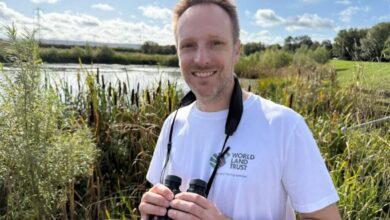Vesper Sparrow – The bird that makes her bed in the grass – Reflections of the Natural World
One Moment in Nature is a reflection back in time to a moment of discovery as I explored the natural settings around me. Through the sharing of this moment, is my hope that readers will become motivated to learn more about our environment and its inhabitants, and become passionate advocates for conservation. One Moment in Nature is a Reflections of the Natural World Blog Post Series by Jim Gain
THE VESPER SPARROW MOMENT – For as long as I can remember birding the grasslands in Eastern Stanislaus County (45+ years), Vesper Sparrows have been an uncommon but regular, winter visitor between October and April. With much consistency, a drive along Cooperstown or Willms Roads would result in the sighting of 2 to 5 of them hanging out with the other grassland birds such as Savannah Sparrows, Western Meadowlarks and Horned Larks. However, during my Stanislaus County Photographic Big Year this year (2025), I have only seen one, once. Jim Ross and I were finishing up a jaunt down Rock River Road when one popped up briefly. I was only able to get one poor, but identifiable shot.
Being somewhat determined to get a better image I set out on a quiet late September morning in hopes of finding one that would cooperate a little better. I was barely a quarter of the way up Cooperstown Road coming from J59 near La Grange when I spied a likely target sparrow perched on a strand of barb wire just next to me. It was visibly larger and overall paler than the multiple Savannah Sparrows and that eyering just called out Vesper Sparrow! As I fumbled with getting my camera up and pointed out my window, it flew across the road in front of me, showcasing its white outer tail feathers. Then I noticed movement along the fenceline from where the first one had been and another Vesper Sparrow had basically taken its perch. Over the next 25 minutes I was fortunate that not a single vehicle came along the road and I was eventually able to see 4 of them at one time along the barbed wire.
PHYSICAL DESCRIPTION – The Vesper Sparrow is a medium-sized, streaky brown songbird with a white eye ring, pale underparts, and distinctive white outer tail feathers that flash in flight. It also features a subtle chestnut patch on the shoulder, most visible when perched or preening.
COMMON NAME ORIGEN – The vernacular name “Vesper” comes from naturalist John Burroughs’s description of the Vesper Sparrow’s tinkling song as being especially lovely and magnificent in the evening. They inhabit grasslands, open valleys, and dry steppes, and complement the splendor and vivacity of the setting sun with their melodious evening songs that acknowledge the day’s departure and ask for safe passage into the night. In 1854, Henry David Thoreau referenced it as the bay-winged bunting in his Journal entry.
SCIENTIFIC NAME MEANING – Their scientific name comes from Greek “poa’s” meaning grass and “oikētēs” dweller hence the title “The bird that makes her bed in the grass” or sometimes called Grass Finch. This species sings in the morning and during the day, but often continues its double-noted song into the twilight of vespers, after most other birds have become still. The Vesper Sparrow is a large, pale, brown-streaked sparrow with white outer tail feathers and rufous lesser wing coverts.
STATUS IN CALIFORNIA’S CENTRAL VALLEY – The Vesper Sparrow (Pooecetes gramineus) occurs locally in California’s Central Valley during the winter months, favoring open grasslands, weedy fields, and agricultural margins, especially in the northern and western portions of the valley. It is generally uncommon and patchily distributed, often seen foraging on the ground in loose flocks, with its subtle plumage and white outer tail feathers aiding identification. The species is listed as Least Concern by the IUCN, with a broad North American range and a stable population, though breeding populations in California are limited and declining due to habitat loss. Natural history observations highlight its ground-nesting behavior, insect and seed-based diet, and melodic song delivered from low perches during the breeding season elsewhere in its range.
Most recent Blog Posts from the One Moment in Nature series.




